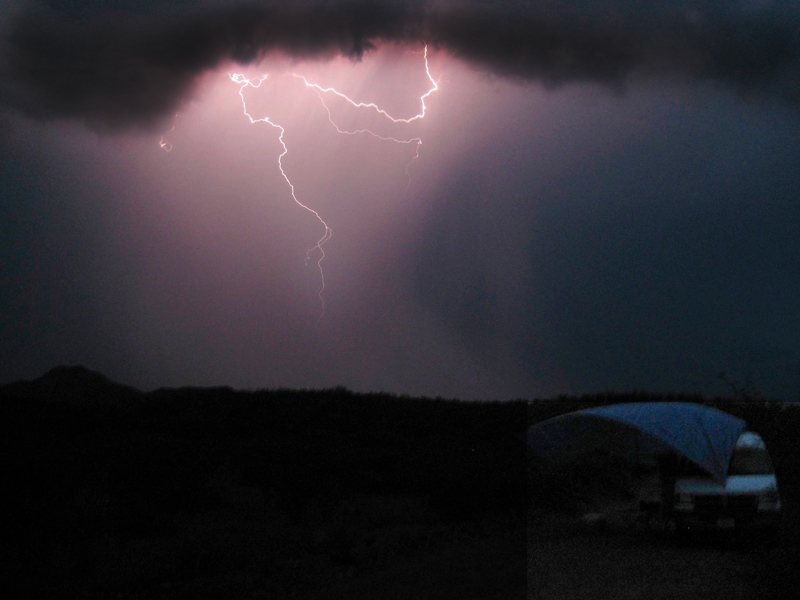Wow imekuwa ni wiki chache tangu post yangu ya mwisho, na mimi nina kidogo aibu kuwa basi ni kwenda muda mrefu. Nini mimi imekuwa juu kwa? Si wote si. Hakuna safari ya kuvutia kukusanya, hakuna aina mpya au uvumbuzi. Kwa kweli mimi tumekuwa ameketi darubini dissecting genitalia au databasing inzi vimelea. Itabidi nifanye chapisho la kufuata ili kuangazia hizo zaidi…
Lakini kwa sasa, hapa kuna fomu ya picha Agosti iliyopita. Nilikuwa nimesimama kwenye sehemu ya wazi ya jangwa la Chihuahuan nje ya Douglas Arizona; umbali wa maili moja kutoka mpaka wa Mexico. Nilifika jioni hiyo na mkusanyaji mwenzangu, microlepidopterist Peter Rukia, na tulikuwa tumepiga kambi wakati ngurumo zilipokuwa zikikaribia. Kando na koni zilizotoweka zinazotuzunguka na mhamiaji haramu wa mara kwa mara, tulikuwa pekee (na ya juu zaidi) kitu karibu kwa maili. Lakini umeme ulikuwa mgumu sana kupinga, Nahitaji picha! Lakini sikuwa na kutolewa kwa cable, wala tripod, au hata kamera nzuri. Basi nini cha kufanya… Nilichagua chaguo la fikra la kusimama nje 40 dakika na Canon yangu kumweka-na-risasi. nilikosa 99% kwa kila risasi niliyopiga, huku kila dakika zilivyokuwa zikienda umeme ulikua unakaribia. hatimaye, Nilijikwaa kwenye picha hii nzuri. Dhoruba iliishia kuwa fupi, tunajibanza kwenye gari (kwamba unaweza tu kufanya nje katika picha) huku umeme ukiwa umekaribia na kutunyeshea kwa saa moja kisha kusonga mbele. Kukusanya usiku huo ilikuwa ya kuvutia. Kulikuwa na nondo nyingi kwenye mtego kiasi kwamba kila kitu kilikuwa kimepigwa. Nilifanikiwa kuokoa wachache wa vielelezo vyema, lakini somo limejifunza kwa wakati ujao.


Dazzling. I’ve found my best blacklighting also when a whopper of a storm is brewing – don’t know what it is about that weather that makes the bugs so active.
I’ve noticed the odd night here or there where the moths in the trap seemed to be exceptionally ratty, and I’ve wondered at the cause and how to prevent it. The fact that it wasn’t happening every night ruled out the trap itself as the ultimate cause, though if, as you say, it’s due to too many individuals inside at once then I suppose the trap is partly to blame. How to get around it? Larger trap? Two traps together? Turn it off halfway through the night? (But what about the late-night flyers?)
I think there are a handful of factors, first and foremost being the percentage of strong flying moths (like Sphingidae) or beetles. But that seems pretty obvious, 40 flapping sphingids in the trap turns it into a vortex, or beetles run around destroying things.
I think it also depends on the killing agent you are using, wind, and how well the trap is sealed. On the most humid of humid nights acetate seems to start failing, where cyanide in the trap would be ideal.
I’m headed to Southern TX in a few weeks and I’ve made some preparations – I’ve built screens that will fit around my traps to keep out the big stuff, and I’ve prepared to have three jars of acetate per trap. Kwa matumaini, that will do it!! The alternative is to completely swap out the traps two or three times over the course of the night, which is something I know people do (sigh).
Back in the day, we used BOTH ethyl acetate and potassium cyanide, because acetate was good for the smaller moths and cyanide provided a faster knock-out of the heavier, destructive, tromping beetles. Moist, wet weather definitely plays a part; you certainly want your trap dry for the equipment, both killing agents to work effectively, and the quality of the catch. We also used a timer for the UV light (both AC and DC) – one of those plug-in varieties that allow you to set the hours of when something should be on and off. This was mainly due to the fact that we had up to 20 traps across 3 counties to set and collect once a week for 4 months every summer for over 10 miaka. Ninashuku kuwa kipima muda kinaweza kubadilishwa kwa urahisi kukusanya kwa vipindi fulani au vingi katika usiku wowote, kulingana na malengo yako.
ps – Chris, ni sayansi gani hii ya kusini ninayoona kwenye anwani yako? Nikienda kwa WordPress yako ya kawaida, Seabrooke na jibu lako halionyeshi.
Hiyo ni tani ya mitego! Utafiti huu ulikuwa wa kazi gani?
Na- Nimehamisha blogi yangu yote kwenye mtandao wa sayansi ya kukaanga kusini, blogu ya zamani ya wordpress itakuwepo tu kama kumbukumbu na hakuna masasisho yatafanywa. Kwa hivyo tafadhali badilisha viungo vyako vya ukurasa mpya, shukrani!
Kutokuwa mkusanyaji (isipokuwa picha), Ninaishi kwenye mtego ili acetate/sianidi isiwe kitu ambacho ningehitaji kufikiria. Lakini ninaweza kuona jinsi mbawakawa na nondo nzito wanavyoweza kuchochea mambo. I hadn’t really paid attention to their numbers in the catch on those nights versus others. (I can’t even imagine 40 sphingids in the trap at once! A busy sphinx night for me might be a dozen). Screens are an interesting thought. I wonder how many smaller moths you’d lose by having something they could bump into or land on.
I’m not a collector anymore, either, Seabrooke. Do you have any sample pics of the plates in your new book?
Seabrooke, I found a couple pics of your book plates online. Nice! I like the natural poses over pinned and stretched moth specimens. Good job.